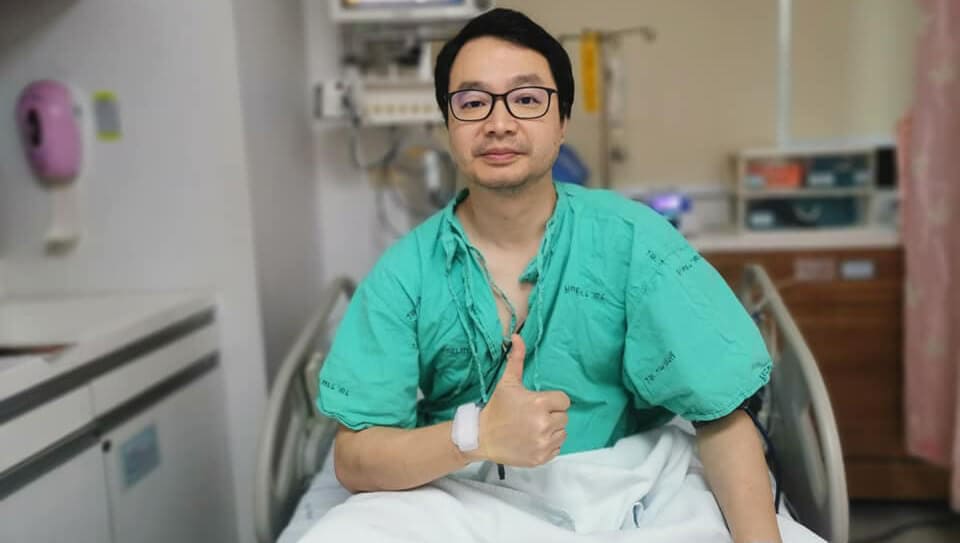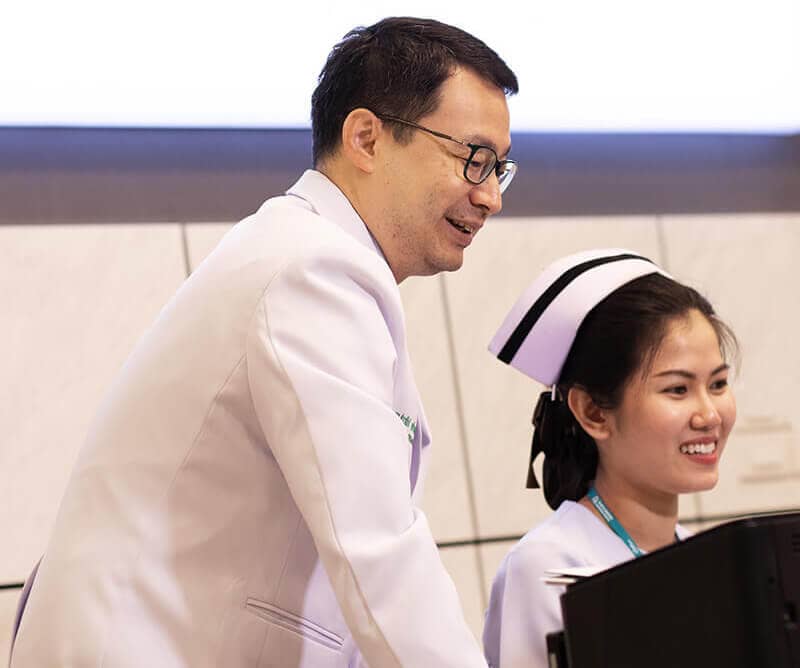For over 20 years, Dr Suvanich Triamchanchoochai has been consulting patients with heart disease in Bangkok, Thailand. Here he shares his story of living through a heart attack and the lessons he now shares with patients.
Dr Suvanich Triamchanchoochai is a Cardiologist at Nakornthon Hospital in Bangkok, Thailand. He specialises in Cardiovascular and Metabolic Syndrome (Diabetes, Hyperlipidemia, and Stroke).
Forty-four year old Suvanich Triamchanchoochai likes to keep active. “I spend at least 30 minutes nearly every morning swimming. Since I am always busy at work, this is my way of relaxing without interruptions.”
On average, he clocks anywhere between 12 to 14 hours while at work. And as a father-of-three, evenings revolve around his children, “whether it is helping them with their homework or putting them to bed, it is the highlight of my day.”
“My kids are growing up and I want to spend as much time as I can with them before they get busy with high school and friends,” he says with a wistful smile and an all too common complaint among parents of pre-teen children.
As a cardiologist, Dr Suvanich has a demanding schedule.
“On average, I see about 50 to 70 patients every day.” Dr Suvanich’s days are packed with patient consultations, team meetings, and lectures at many hospitals. “When I started 20 years ago, I chose cardiology because of the impact it has on the lives of patients. The burden of cardiovascular disease was increasing in Thailand back then, and it continues even today.”
“However, the patient profile is changing,” he adds. “I see younger patients in their 30s and 40s. Many patients have existing co-morbidities. All of these add to the complexity of disease management.”
“But early intervention can save lives and that is the greatest reward for any cardiologist.”
The call that changed my life
“I remember I was particularly exhausted by the time I got home that day.”
As on other evenings, Dr Suvanich had dinner with his family but decided to sleep early. “I was on call that night, and I was not feeling too well. So I thought some rest would help.”
At 9:30 PM, Dr Suvanich got a call from the on-duty nurse. “She was updating me on a patient. I knew she was talking, but I could not hear anything. I ended the call abruptly.”
Then it started. Dr Suvanich began feeling uneasy. “I vomited but that did not help. When the chest pain began, I knew.”
Since dinner, Dr Suvanich had been feeling unwell which he put down to heartburn. When the tightness in his chest did not subside, he called on his wife and asked her to drive him to the hospital.
“I think I am having a heart attack”.
He recalls saying to his wife.
“I live close to Nakornthon Hospital, Bangkok, where I work, and told her to drive us there straight away.”
From the car, he called the Accident and Emergency (A&E) department at the hospital and spoke to the registrar on night shift, asking them to be on standby to prepare the medication and all necessary equipment.
Next, he called his friend, an interventional cardiologist describing the symptoms, “My friend asked me who the patient was.”
When Dr Suvanich told him, “I could hear the shock in my friend’s voice. As a doctor, you often treat patients you do not know. What happens when that patient is a friend or a loved one?”
I have seen countless cases where a patient decided to wait. But in a heart attack every minute counts.

In the case of an Acute Myocardial Infarction (AMI), also commonly called a heart attack, the blood supply to an area of the heart muscle is interrupted, causing the muscle cells to die. Prompt treatment is essential as every 30 minutes of delay increases the relative risk of mortality by 7.5% in such patients.1
To act without delay
Patients with chest pain and other symptoms suggestive of AMI account for approximately 10-20% of all emergency room consultations.2 “It is important for doctors in such situations to know quickly whether a patient is suffering from a life-threatening cardiac episode or if the chest pain is caused by other reasons,” says Dr Suvanich.
The mortality rate of heart attacks is highest within hours of onset, so early diagnosis and initiation of treatment can mean the difference between life and death.
“Diagnostic tools such as cardiac biomarkers are crucial to support rapid and accurate diagnosis,” he adds. “When I was admitted, they did a Troponin T-test to confirm that it was indeed a heart attack.”
Why is the rapid diagnosis of heart attacks crucial?
A limitation of the earlier generations of blood tests was the time required to detect the troponin release, sometimes requiring up to 6 hours with less sensitive troponin tests.
Rapid treatment is essential as every 30 minutes increases the risk of mortality by 7.5% in patients.6

From doctor to patient

Hospital in Bangkok, Thailand.
This was a defining moment for Dr Suvanich. “Up until that moment, I did everything that my years of training taught me. I remained calm, gave instructions, and stayed alert. I was the doctor.”
“But the diagnosis, which wasn’t a surprise to me, shifted something. I realised I had been functioning on auto-pilot and decided the best course of action was to leave it to the experts,” he says.
“I gave up control and went from being a doctor to a patient.”
Doctors performed a Percutaneous Coronary Intervention (PCI) on Dr Suvanich. This non-surgical procedure uses a catheter to insert a stent to open up blood vessels in the heart.
Living in the moment
“An experience like this changes your outlook.”
“A year ago, 24 hours a day did not seem enough. Today, I realise you will always find time to do the things that matter.”
After the PCI, Dr Suvanich decided to re-evaluate his life. “I thought of all the commitments that kept me busy, of the camping trips with my family I had not found time for.”
“As a doctor, my patients are always my priority but I needed to readjust how I had been living my life. I wanted to be a good doctor but it is equally important for me now to be a good father and a good husband. Work-life balance is also important.”
The hardest part was calling his 13-year old daughter who was in Singapore. “You do not ever want to make such a call. It breaks your heart when your children worry about you. I told her daddy had a heart attack but I am here now.”

Putting heart in patient care
“My heart attack has made me a better doctor. Before this, I spent time counseling patients on prevention and treatment.”
“I now speak to them in a language that I know they understand. I use my experience to lessen their fears and to let them know that I am with them on this journey, every step of the way.”
“I was always active and had a fairly good lifestyle. Yet, I realise I was not getting enough sleep, I was under a lot of stress, and my eating habits were not good. A culmination of many things brought on the heart attack.”
“I was lucky that night. What if the nurse had not called me?”
“So I always tell my patients do not assume it cannot happen to you. Take care of yourself, know the signs and symptoms, and go to the hospital without delay.”
Read more inspirational patient stories at Roche Diagram.
Learn more about how Troponin T-high sensitive test helps with the rapid diagnosis of myocardial infarction (heart attack).

References:
1Mueller C, Giannitsis E, Christ M, et al. 2016. Multicenter evaluation of a 0-hour/1-hour algorithm in the diagnosis of myocardial infarction with high-sensitivity cardiac Troponin T. Ann Emerg Med. 68(1):76-87.
2Shiozaki M, Inoue K, Suwa S, et al. 2017. Utility of the 0-hour/1-hour high-sensitivity cardiac troponin T algorithm in Asian patients with suspected non-ST elevation myocardial infarction. Int J Cardiol. 249:32-35.
3Twerenbold, R. et al. 2016. Eur Heart J. 37(44), 3324 – 3332.
4Giannitsis E et al. 2010. Clin Chem. 56 (2), 254-61.
5Roffi M et al. 2016. Eur Heart J. 37(3):267-315.
6De Luca G. et al. 2004: Circulation. 109(10) ;1223-5.
7Mueller C, Giannitsis E, Christ M, et al. 2016. Multicenter evaluation of a 0-hour/1-hour algorithm in the diagnosis of myocardial infarction with high-sensitivity cardiac Troponin T. Ann Emerg Med. 68(1):76-87.
8Shiozaki M, Inoue K, Suwa S, et al. 2017. Utility of the 0-hour/1-hour high-sensitivity cardiac troponin T algorithm in Asian patients with suspected non-ST elevation myocardial infarction. Int J Cardiol. 249:32-35.














